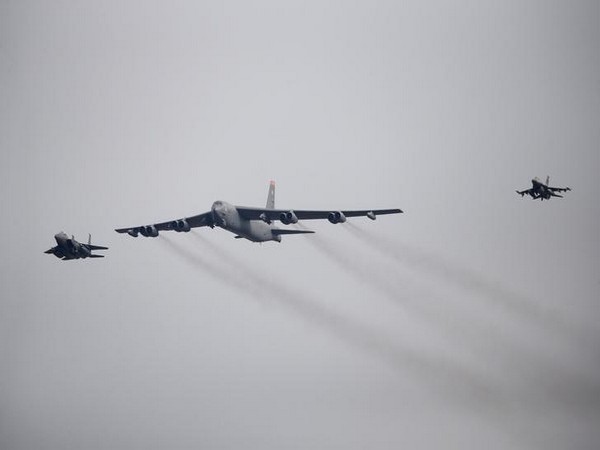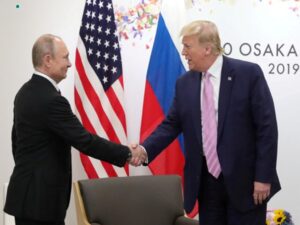
A U.S. Air Force B-52 (C) flies over Osan Air Base in Pyeongtaek, South Korea, January 10, 2016. REUTERS/Kim Hong-Ji
New Delhi [India], Aug 24 (ANI): The deployment of three B-2 stealth bombers by the United States, capable of carrying nuclear weapons, in the Indian Ocean island of Diego Garcia, is sending a clear message to deter China from starting a war in the India-Pacific.
Military tensions are showing no signs of abating in two possible regional theatres — Ladakh, on the India–China border, and Taiwan.
The three radar-evading bombers, widely recognised as the most advanced in the world, arrived at Diego Garcia on August 12.
By deploying at the Indian Ocean island, which falls under the US Indo-Pacific Command (INDOPACOM), China was being sent an unambiguous signal–that Washington was committed to safeguard the sea lanes of the Indian Ocean, South China Sea and the Pacific Ocean, under well-defined rules. Unsurprisingly, the US task force commander, Lieutenant Colonel Christopher Conant nailed Washington’s resolve to uphold the strategic defence of the two-oceans, after touchdown at Diego Garcia, following a 29-hour long flight from the US, involving mid-air refuelling several times. “We are excited to return to this important location. [Diego Garcia] puts the ‘INDO’ in INDOPACOM [US Indo-Pacific Command],” he observed.
Because of their ultra-long-range endurance, and freedom to pick any target of choice, as hostile country radars cannot pick these planes and destroy them, the B-2 planes can carry out punishing bombing raids in more than one theatre from its forward base–in the present case, Diego Garcia.
The deployment of the B-52 trio should not be seen in isolation. These planes are joining six B-52 Stratofortress bombers which had been dispatched six months ago, and continue to remain, in the archipelago.
In tune with the landing of the B-2 planes, the formidable US aircraft carrier, USS Ronald Reagan, had steamed into the South China Sea on August 14.
When these deployments, carrying enormous firepower, in the air and sea, are taken together, the multiple messaging to China is clear. In the South China Sea, the US was announcing that any Chinese attack and takeover of Pratas or Dongsha Islands of Taiwan was a red line. This is not surprising. These Taiwanese islands have significant strategic value. They are located 310 kilometres southeast of Hong Kong between the South China Sea and the Pacific Ocean. All PLA Navy (PLAN) vessels must pass those islands before they can reach the Pacific Ocean, where they would be harder to track. The takeover of these islands by China will therefore significantly enhance Beijing’s capacity to project power far away from its shores.
The concentration of naval and air power in the South China Sea, has preceded China‘s live fire drills 545 kilometres north of Taiwan near the Zhoushan Islands. These manoeuvres have been widely seen as a dress rehearsal for a Chinese takeover of the Pratas Islands, which Beijing claims are part of its Guangdong province.
To reinforce its readiness to confront China, the US has announced that F-16 planes that will be exported to Taiwan, will be armed with Harpoon anti-ship missiles. On August 14, the day when USS Ronald Reagan sailed into the South China Sea, the Pentagon announced that Taiwan had signed a USD 62 billion deal for the latest version of F-16 planes.
The B-2 bombers have high strategic relevance in the Ladakh region as well. Specifically, they can be used to destroy the 4,000-kilometre range DF-26 ballistic missiles, which can mount either nuclear or conventional warheads. There have been reports that DF-26 systems have appeared in Korla, in Xinjiang region not far from the Ladakh theatre.
So far, it was anticipated that the DF-26 missiles would target US aircraft carriers in the West Pacific or the island of Guam–a key military base of the US Indo-Pacific command, in the West Pacific.
But with the deployments in Korla, the Chinese maybe signalling their intent to target ships, including aircraft carriers, of the Indo-Pacific Quad, comprising India, US, Japan and Australia. The foursome is expected to scale up its military interaction, following growing tensions with China after the outbreak of the Covid-19 pandemic. The quad is expected to hold a major large-scale military exercise later this year.
The reinforcement of Diego Garcia with strategic bombers, is also expected to send a signal to China, not to consider targeting Guam, with DF-26 missiles.
The base at Guam is central to what is called the “second island chain” to keep an expansionist China in check. The Second Island Chain encloses the west Pacific from the Aleutians, Guam, and down to Darwin in Australia. Guam is connected to an area, covering Darwin in Australia in the south to Aleutians — a chain of 14 large volcanic islands and 55 smaller islands mostly belonging to the U.S. state of Alaska in the north.
Guam also helps sustain what is called the first island chain, meant to keep a lid on China‘s strategic ambitions. It encloses five seas–Sea of Okhotsk , Sea of Japan, Yellow Sea, East China Sea and the South China Sea. The lengthy network of the first island chain starts from the Kamchatka peninsula in Russia’s Far East and weaves its way into Japan. Then, from the southernmost part of the Japanese mainland, it passes through Okinawa, a part of a larger Ryukyu island chain which ends with Taiwan. From Taiwan, the “first island chain” heads towards the Philippines and the island of Borneo, before looping towards the tip of the Malay Peninsula.
Some analysts say that with strategic bombers at their command in Diego Garcia, the Americans can carry out a morale sapping strike on the Shandong–a brand new Chinese aircraft carrier which has been deployed in the South China Sea. “Deploying long-range bombers to Diego Garcia and the carrier group into the South China Sea sends a clear message from the US that the Chinese government should not think about attacking Guam. If China makes such a move, the US could launch long-range stealth bombers from Diego Garcia against a range of targets, including the PLA aircraft carrier Shandong, in the South China Sea,” writes Andrew Banfield is a senior lecturer in the School of Politics and International Relations at the Australian National University, in the Strategist.
Despite the credible show of the flag, the jury is still out whether this would be sufficient to extinguish Chinese nationalistic ambitions in the Indo-Pacific or, instead, a clearer demonstration of military resolve by the region’s democracies and like-minded countries would be required to change regime behaviour in the Xi Jinping-led China. (ANI)

















